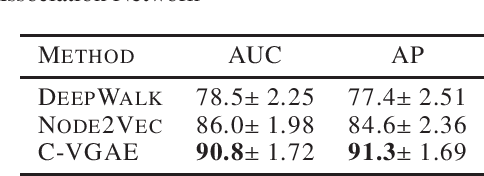Towards Probabilistic Generative Models Harnessing Graph Neural Networks for Disease-Gene Prediction
Paper and Code
Jul 12, 2019

Disease-gene prediction (DGP) refers to the computational challenge of predicting associations between genes and diseases. Effective solutions to the DGP problem have the potential to accelerate the therapeutic development pipeline at early stages via efficient prioritization of candidate genes for various diseases. In this work, we introduce the variational graph auto-encoder (VGAE) as a promising unsupervised approach for learning powerful latent embeddings in disease-gene networks that can be used for the DGP problem, the first approach using a generative model involving graph neural networks (GNNs). In addition to introducing the VGAE as a promising approach to the DGP problem, we further propose an extension (constrained-VGAE or C-VGAE) which adapts the learning algorithm for link prediction between two distinct node types in heterogeneous graphs. We evaluate and demonstrate the effectiveness of the VGAE on general link prediction in a disease-gene association network and the C-VGAE on disease-gene prediction in the same network, using popular random walk driven methods as baselines. While the methodology presented demonstrates potential solely based on utilizing the topology of a disease-gene association network, it can be further enhanced and explored through the integration of additional biological networks such as gene/protein interaction networks and additional biological features pertaining to the diseases and genes represented in the disease-gene association network.
 Add to Chrome
Add to Chrome Add to Firefox
Add to Firefox Add to Edge
Add to Edge